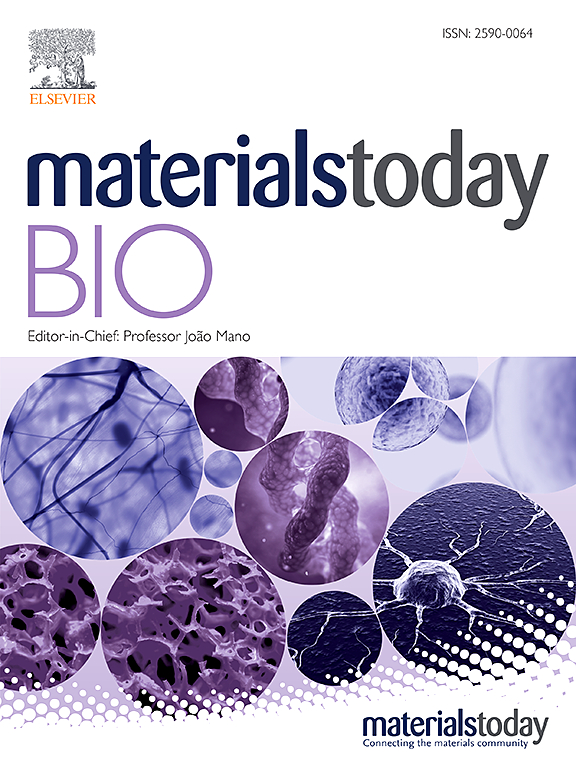Multifunctional hydrogel based on polyvinyl alcohol/chitosan/metal polyphenols for facilitating acute and infected wound healing
IF 8.7
1区 医学
Q1 ENGINEERING, BIOMEDICAL
引用次数: 0
Abstract
Bacterial-infected wounds could cause delayed wound healing due to increased inflammation, especially wounds infected by drug-resistant bacteria remain a major clinical problem. However, traditional treatment strategies were gradually losing efficacy, such as the abuse of antibiotics leading to enhanced bacterial resistance. Therefore, there was an urgent need to develop an antibiotic-free multifunctional dressing for bacterially infected wound healing. This study demonstrated the preparation of a multifunctional injectable hydrogel and evaluated its efficacy in treating acute and infected wounds. The hydrogel was prepared by a one-step mixing method, and cross-linked by natural deep eutectic solvent (DES), polyvinyl alcohol (PVA), chitosan (CS), tannic acid (TA), and Cu2+ through non-covalent interactions (hydrogen bonds and metal coordination bonds). PVA/CS/DES/CuTA500 hydrogel has multiple functional properties, including injectability, tissue adhesion, biocompatibility, hemostasis, broad-spectrum antibacterial, anti-inflammatory, and angiogenesis. Most importantly, in the MRSA-infected skin wound model, PVA/CS/DES/CuTA500 hydrogel could ultimately accelerate infected wound healing by killing bacteria, activating M2 polarization, inhibiting inflammation, and promoting angiogenesis. In summary, the PVA/CS/DES/CuTA500 hydrogel showed great potential as a wound dressing for bacterial infected wounds treatment in the clinic.
基于聚乙烯醇/壳聚糖/金属多酚的多功能水凝胶用于促进急性和感染性伤口愈合
受细菌感染的伤口会因炎症加重而导致伤口延迟愈合,尤其是受耐药细菌感染的伤口仍然是一个主要的临床问题。然而,传统的治疗策略正逐渐失去疗效,如滥用抗生素导致细菌耐药性增强。因此,开发一种用于细菌感染伤口愈合的无抗生素多功能敷料迫在眉睫。本研究展示了一种多功能注射水凝胶的制备方法,并评估了其治疗急性感染伤口的疗效。该水凝胶采用一步混合法制备,由天然深共晶溶剂(DES)、聚乙烯醇(PVA)、壳聚糖(CS)、单宁酸(TA)和 Cu2+ 通过非共价相互作用(氢键和金属配位键)交联而成。PVA/CS/DES/CuTA500 水凝胶具有多种功能特性,包括注射性、组织粘附性、生物相容性、止血、广谱抗菌、抗炎和血管生成。最重要的是,在 MRSA 感染的皮肤伤口模型中,PVA/CS/DES/CuTA500 水凝胶可通过杀灭细菌、激活 M2 极化、抑制炎症和促进血管生成,最终加速感染伤口的愈合。总之,PVA/CS/DES/CuTA500 水凝胶作为一种伤口敷料,在临床治疗细菌感染伤口方面显示出巨大的潜力。
本文章由计算机程序翻译,如有差异,请以英文原文为准。
求助全文
约1分钟内获得全文
求助全文
来源期刊

Materials Today Bio
Multiple-
CiteScore
8.30
自引率
4.90%
发文量
303
审稿时长
30 days
期刊介绍:
Materials Today Bio is a multidisciplinary journal that specializes in the intersection between biology and materials science, chemistry, physics, engineering, and medicine. It covers various aspects such as the design and assembly of new structures, their interaction with biological systems, functionalization, bioimaging, therapies, and diagnostics in healthcare. The journal aims to showcase the most significant advancements and discoveries in this field. As part of the Materials Today family, Materials Today Bio provides rigorous peer review, quick decision-making, and high visibility for authors. It is indexed in Scopus, PubMed Central, Emerging Sources, Citation Index (ESCI), and Directory of Open Access Journals (DOAJ).
 求助内容:
求助内容: 应助结果提醒方式:
应助结果提醒方式:


